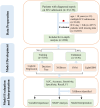Interpretable machine learning-based prediction of 28-day mortality in ICU patients with sepsis: a multicenter retrospective study
- PMID: 39844844
- PMCID: PMC11751000
- DOI: 10.3389/fcimb.2024.1500326
Interpretable machine learning-based prediction of 28-day mortality in ICU patients with sepsis: a multicenter retrospective study
Abstract
Background: Sepsis is a major cause of mortality in intensive care units (ICUs) and continues to pose a significant global health challenge, with sepsis-related deaths contributing substantially to the overall burden on healthcare systems worldwide. The primary objective was to construct and evaluate a machine learning (ML) model for forecasting 28-day all-cause mortality among ICU sepsis patients.
Methods: Data for the study was sourced from the eICU Collaborative Research Database (eICU-CRD) (version 2.0). The main outcome was 28-day all-cause mortality. Predictor selection for the final model was conducted using the least absolute shrinkage and selection operator (LASSO) regression analysis and the Boruta feature selection algorithm. Five machine learning algorithms including logistic regression (LR), decision tree (DT), extreme gradient boosting (XGBoost), support vector machine (SVM), and light gradient boosting machine (lightGBM) were employed to construct models using 10-fold cross-validation. Model performance was evaluated using AUC, accuracy, sensitivity, specificity, recall, and F1 score. Additionally, we performed an interpretability analysis on the model that showed the most stable performance.
Results: The final study cohort comprised 4564 patients, among whom 568 (12.4%) died within 28 days of ICU admission. The XGBoost algorithm demonstrated the most reliable performance, achieving an AUC of 0.821, balancing sensitivity (0.703) and specificity (0.798). The top three risk predictors of mortality included APACHE score, serum lactate levels, and AST.
Conclusion: ML models reliably predicted 28-day mortality in critically ill sepsis patients. Of the models evaluated, the XGBoost algorithm exhibited the most stable performance in identifying patients at elevated mortality risk. Model interpretability analysis identified crucial predictors, potentially informing clinical decisions for sepsis patients in the ICU.
Keywords: 28-day mortality; XGBoost; machine learning; multicenter retrospective study; sepsis.
Copyright © 2025 Shen, Wu, Lan, Chen, Wang and Li.
Conflict of interest statement
The authors declare that the research was conducted in the absence of any commercial or financial relationships that could be construed as a potential conflict of interest.
Figures




Similar articles
-
Supervised Machine Learning Models for Predicting Sepsis-Associated Liver Injury in Patients With Sepsis: Development and Validation Study Based on a Multicenter Cohort Study.J Med Internet Res. 2025 May 26;27:e66733. doi: 10.2196/66733. J Med Internet Res. 2025. PMID: 40418571 Free PMC article.
-
Interpretable prediction of hospital mortality in bleeding critically ill patients based on machine learning and SHAP.BMC Med Inform Decis Mak. 2025 Jul 15;25(1):263. doi: 10.1186/s12911-025-03101-9. BMC Med Inform Decis Mak. 2025. PMID: 40665292 Free PMC article.
-
Machine learning based screening of biomarkers associated with cell death and immunosuppression of multiple life stages sepsis populations.Sci Rep. 2025 Aug 19;15(1):30302. doi: 10.1038/s41598-025-14600-0. Sci Rep. 2025. PMID: 40830558 Free PMC article.
-
Construction and validation of HBV-ACLF bacterial infection diagnosis model based on machine learning.BMC Infect Dis. 2025 Jul 1;25(1):847. doi: 10.1186/s12879-025-11199-5. BMC Infect Dis. 2025. PMID: 40596896 Free PMC article.
-
Significant adverse prognostic events in patients with urosepsis: a machine learning based model development and validation study.Front Cell Infect Microbiol. 2025 Aug 8;15:1623109. doi: 10.3389/fcimb.2025.1623109. eCollection 2025. Front Cell Infect Microbiol. 2025. PMID: 40861482 Free PMC article.
Cited by
-
Interpretable machine learning-based prediction of mortality in critical cancer patients with delirium: A retrospective cohort study.Asia Pac J Oncol Nurs. 2025 Jul 19;12:100760. doi: 10.1016/j.apjon.2025.100760. eCollection 2025 Dec. Asia Pac J Oncol Nurs. 2025. PMID: 40747249 Free PMC article.
-
Development and Validation of Machine Learning Models for Predicting 7-Day Mortality in Critically Ill Patients with Traumatic Spinal Cord Injury: A Multicenter Retrospective Study.Neurocrit Care. 2025 Jun 25. doi: 10.1007/s12028-025-02308-y. Online ahead of print. Neurocrit Care. 2025. PMID: 40563047
-
The Prognostic Value of the CALLY Index in Sepsis: A Composite Biomarker Reflecting Inflammation, Nutrition, and Immunity.Diagnostics (Basel). 2025 Apr 17;15(8):1026. doi: 10.3390/diagnostics15081026. Diagnostics (Basel). 2025. PMID: 40310418 Free PMC article.
-
Development and temporal validation of a nomogram for predicting ICU 28-day mortality in middle-aged and elderly sepsis patients: An eICU database study.PLoS One. 2025 Jul 21;20(7):e0328701. doi: 10.1371/journal.pone.0328701. eCollection 2025. PLoS One. 2025. PMID: 40690422 Free PMC article.
References
-
- Baysan M., Arbous M. S., Steyerberg E. W., van der Bom J. G. (2022). Prediction of inhospital mortality in critically ill patients with sepsis: confirmation of the added value of 24-hour lactate to acute physiology and chronic health evaluation IV. Crit. Care Explor. 4, e0750. doi: 10.1097/CCE.0000000000000750 - DOI - PMC - PubMed
Publication types
MeSH terms
LinkOut - more resources
Full Text Sources
Medical

